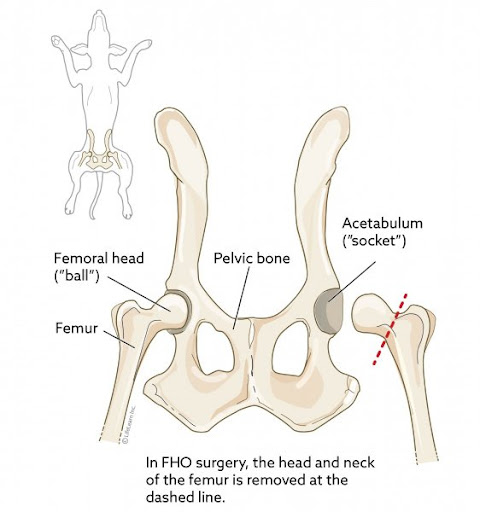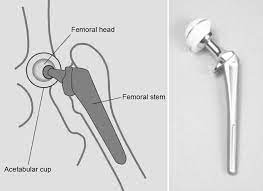Hip Dysplasia in Dogs
What is hip dysplasia?
The hip is what we call a “ball-and-socket joint” (Figure 1). For the joint to work well, the “ball” (or the head of the femur/ thigh bone) and “socket” (or acetabulum of the pelvis) need to sit together securely. This joint sits within a tough fibrous joint capsule and contains a joint lubricant to help reduce friction during movement. Additionally, the surface of where the bones meet is also covered by smooth cartilage.
Hip dysplasia is a deformity of the hip joint that occurs during growth. It occurs where the growth of the ball and socket do NOT grow at equal rates during puppyhood. This discrepancy in growth rates results in laxity (looseness) of the joint, often due to either too shallow or flattened “socket” or a malformed “ball”. As the body attempts to stabilise the joint, there will be progressive loss of cartilage and formation of bony spurs (osteophytes) and scar tissue. This eventual degeneration results in early degenerative joint disease (DJD) or osteoarthritis (OA).

Figure 1: The ball and socket joint (Photo by My Vet Animal Hospital)
Hip dysplasia can be caused by a variety of factors including:
- Genetic
- Obesity/ being overweight
- Nutrition imbalance
- Strenuous exercise in a young growing puppy
- Joint laxity (looseness) due to failure of muscles or soft tissue to
- hold the joint in full congruity
Hip dysplasia is more commonly seen in large breed dogs such as:
- German Shepherds
- St. Bernards
- Labradors
- Golden Retrievers
- Rottweiler
- American Staffordshire Terriers
- Newfoundlands
However, hip dysplasia can affect any breed including smaller-to-medium sized breeds such as:
- French Bulldogs
- Pembroke Welsh Corgi
- Pug
What are the signs I should watch out for?
Many younger and larger breeds with hip dysplasia tend to walk and run without showing significant signs of pain until a later stage, where there is a progression of arthritis. It is therefore recommended to have hip screening in puppies that have a breed predisposition to having hip dysplasia. Some signs to look out for in a dog with hip dysplasia include:
- Weakness and pain in the hind legs
- Lack of coordination
- Abnormal gait- waddle, hopping, swaying of the hips
- Abnormal posture- elevated pelvis, low head position and hunched/ arched back to shift body weight to the forelimbs
- Grinding or grating (crepitus) feeling associated with rotation of the hip joint
- Reluctance to move or stand up
- Wasting of large muscle areas in the hind legs
- Pain on the palpation of the hip flexor muscles (e.g. iliopsoas muscles)

Figure 2: Position to test for the Ortolani sign (Illustration by Samantha J. Elmhurst from Clinician’s Brief
How do you diagnose hip dysplasia?
Early intervention is crucial for the management of hip dysplasia. If your dog is showing any clinical signs of hip dysplasia or is a breed that is at-risk, it is important to have a chat with your vet who may then recommend some testing for diagnosis.
1) Hip x-rays: Hip dysplasia is best diagnosed through radiographic x-rays of the hips, as it will allow us to determine the severity of the disease and any degenerative osteoarthritic changes that may already be present. The best diagnostic x-rays are performed when your dog is both completely still and relaxed, so this will usually require full general anaesthesia.
At My Vet, we use the PennHIP method to assess for hip dysplasia. The method involves a specific positioning of the dog when taking the hip radiographs so that the passive hip laxity can be measured objectively. Passive hip laxity is defined as the degree of looseness of the hip ball joint in its socket when the surrounding muscles are completely relaxed. Studies have shown that the degree of hip laxity is a significant contributing factor to the development of degenerative joint disease (DJD) or osteoarthritis (OA). Both DJD and OA are radiographic signs that we use to confirm hip dysplasia in dogs.
2) Ortolani sign: While they are under general anaesthesia, additional physical examination tests may be performed such as palpating for the Ortolani sign. This is where pressure is applied and the hip is moved in such a way that if the joint is loose, the femoral head ‘ball’ will be heard and felt as a ‘clunk’ in and out of the ‘socket’.
How do you treat hip dysplasia
The treatment of hip dysplasia is dependent on severity and can vary from non-surgical management (including nutrition, supplements, physiotherapy, etc.) to surgical management. We will often recommend dogs with hip dysplasia to have an orthopaedic specialist consultation for further evaluation and to discuss the best option that is tailored to your furbaby’s needs.
- Nutrition
Nutrition can play a significant role in the development of hip dysplasia. Large breed puppies should not grow too rapidly as this can lead to bones and muscles growing at different rates, predisposing them to joint diseases like hip dysplasia. Large breed puppies should only be fed food that is labelled ‘for large breed puppies’ to ensure that they grow at a slower but steady pace. For example, your large breed puppy should not be eating a puppy diet that is labelled ‘for all breed sizes’. Growth supplements such as protein and calcium should not be given either unless otherwise told by your veterinarian. - Healthy/ ideal weight
It is essential for your pet to maintain a healthy body weight because increased weight means more pressure on the joints, which can exacerbate the clinical signs of hip dysplasia. Consult your veterinarian to determine how much your dog should weigh and whether a weight loss program is indicated. - Exercise and Physiotherapy
It is important to modify your dog’s exercise habits and encourage low-impact activities to reduce pressure on the joints. This could include short, regular walks to keep your dog mobile but avoid long periods of strenuous exercise with lots of running and jumping. Swimming is a very good low-impact exercise that is gentle on the joints. Physiotherapy can also be very valuable in performing repetitive targeted exercise to strengthen relevant muscle groups to help support movement of the hip joint. - Diet, Joint supplements & Pain Relief Medications
There are many different drugs that can be used to aid in both the repair of damaged cartilage as well as prevention of cartilage damage. These include supplements (such as 4Cyte epiitalis forte gel, fish oils and glucosamine), special diets (Hill’s Metabolic +/- Mobility) and injections (such as Zydax). Your vet will advise you on which is the most suitable for your pet and advise on extra pain relief if required. - Surgery
There are multiple surgical procedures that can be performed to help correct hip dysplasia. The type of surgical procedure is dependent on a number of factors including the age of your puppy at diagnosis and the severity of hip dysplasia
- Juvenile Pubic Symphysiodesis:
This surgery is ideally performed on young puppies before 5 months old, so it is generally done as a preventive procedure once radiographs indicate any signs of a dysplastic hip(s). The pubic symphysis is the cartilage that connects the right side of the pelvis to the left side. As a dog matures, this cartilage converts to bone and the two halves of the pelvis fuse permanently. This surgery prematurely seals the symphysis, which in turn results in rotation of the developing hip sockets into a more normal alignment.

Figure 3: The pelvis(https://caninearthritis.org/article/dod-hip-dyplasia/)

- Double/ Triple Pelvic Osteotomy
This surgery is appropriate for young (age 8-18 months) dogs with hip dysplasia but without degenerative arthritis changes. This means that there is a specific window of opportunity for this surgery and if the dog develops arthritis or becomes too old, this surgery will no longer be suitable. In the DPO/ TPO surgery, the ill-fitting socket is essentially sawed free of the rest of the pelvis, re-positioned for a tighter fit on the femoral head, and then plated back into place (Figure 4). DPO/ TPO on both hips may be required in some dogs. In some cases, surgery on one hip leads to positive changes in the other hip so that surgery on the second hip is not necessary.
- Femoral Head/Neck Ostectomy
This surgery is commonly referred to as the FHO and is best used for smaller or very active dogs. Here, the femoral head is amputated and removed, allowing the joint to heal as a false joint, essentially, just a capsule connecting the two bones but no actual bone to bone contact (Figure 5). If the dog is small and not carrying too much excess weight, a false joint is strong enough to hold the hip. If a dog is very active, a false joint will form quickly. Recovery is a bit slower especially in the first 2-6 weeks but the dog should return to normal function after a couple of months.

Figure 5: Femoral head ostectomy (https://vcacanada.com/know-your-pet/femoral-head-ostectomy-fho-in-dogs

Figure 6: Total hip replacement (left) and the prosthetic components (right) (http://blog.vetbloom.com/surgery/total-hip-replacement/)
- Total Hip Replacement
This procedure is for dogs with established degenerative hip changes. For these dogs, the best choice may be to simply replace the hip or hips with a prosthetic hip (Figure 6). This is a highly invasive procedure, and there is an increased risk of infection but extra precautions for sterility are used (no skin disease can be present in the skin over the hips). Pet owners should expect about 3 months of exercise restriction after as part of the recovery process. Usually only one hip is operated at one time. Sometimes only one hip replacement is needed for certain dogs.
How do you prevent hip dysplasia
Although not all hip dysplasia cases can be prevented in a puppy, proactive measures can be taken to reduce the risk of development of this disease.
Before obtaining a puppy, do some research about the breeds that are predisposed to developing hip dysplasia. If you are obtaining your puppy from a breeder, make sure that they perform appropriate health screening on their breeding dogs. Breeders should provide hip scoring (based on the Canine Hip and Elbow Dysplasia Scheme) of their breeding dogs and only breed from the dogs with a normal or low scoring.
As your puppy grows, provide a healthy and appropriate diet for them to allow a steady growth rate. It is also important to keep your furbaby at an ideal weight and provide gentle exercises to reduce tension on the joints as they grow.
Most dogs with hip dysplasia can live a long, healthy life with the appropriate management and treatment.


